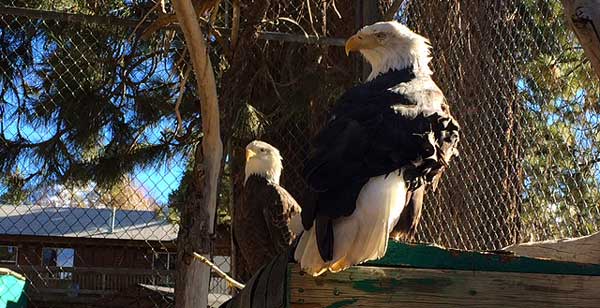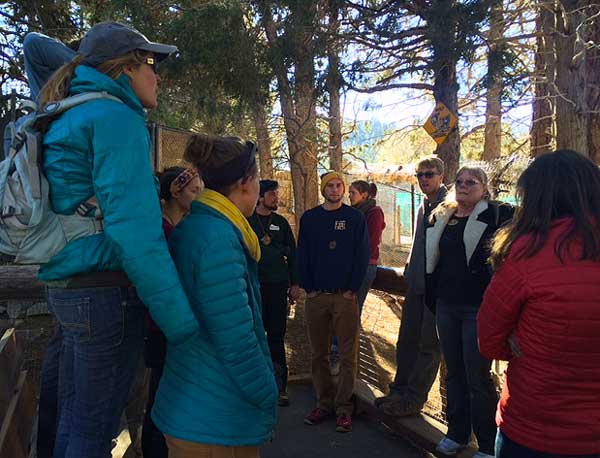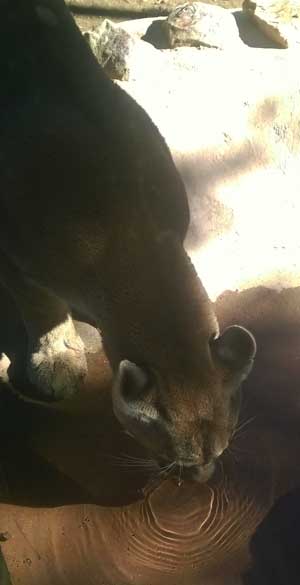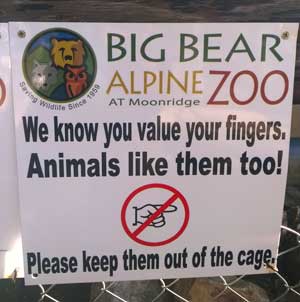 It is a brisk, sunny February afternoon and the Big Bear Alpine Zoo is teeming with curious faces. Families wander along pathways and toddlers are excitedly introduced to wildlife for the first time. There’s even a large, chatty and excited school group that follows a set of tour guides, getting a detailed account of everything the zoo has to offer.
It is a brisk, sunny February afternoon and the Big Bear Alpine Zoo is teeming with curious faces. Families wander along pathways and toddlers are excitedly introduced to wildlife for the first time. There’s even a large, chatty and excited school group that follows a set of tour guides, getting a detailed account of everything the zoo has to offer.
Unlike most school groups, however, these aren’t kids – they are all adults, High Trails instructors on a field trip all of their own.
Instead of the standard Friday schedule of site cleaning and then an inservice, we have been given the opportunity to learn off-site about some of the unique resources that surround us in the Big Bear community. And so we find ourselves being paid to be at the Zoo.
 One of only two alpine zoos in the US, the Big Bear-based organization was created out of necessity in 1959 when a nasty wildfire left many animals wounded and needing care. A group of concerned citizens put together a rescue effort, intending only to rehabilitate the animals injured in the blaze and release them back into the wild.
One of only two alpine zoos in the US, the Big Bear-based organization was created out of necessity in 1959 when a nasty wildfire left many animals wounded and needing care. A group of concerned citizens put together a rescue effort, intending only to rehabilitate the animals injured in the blaze and release them back into the wild.
Unfortunately, many animals were too badly wounded or became too dependent on human assistance to have a chance of surviving on their own, and thus the Big Bear Alpine Zoo was first born. Today, the facility has grown from a small group caring for a black bear and two bobcats to a well-known zoo supporting over 85 species.
 Holding true to its unique roots, this is not a zoo in the typical sense. Every animal in residence is at the facility out of necessity, either because it has been rescued from a harmful situation or because it is in the process of being rehabilitated. An incredible 90% of the animals that stay at the alpine zoo recover and are later released back into the wild. The remaining 10% that can’t make that transition instead become animal ambassadors to local schools and community organizations to educate people on issues surrounding wildlife conservation.
Holding true to its unique roots, this is not a zoo in the typical sense. Every animal in residence is at the facility out of necessity, either because it has been rescued from a harmful situation or because it is in the process of being rehabilitated. An incredible 90% of the animals that stay at the alpine zoo recover and are later released back into the wild. The remaining 10% that can’t make that transition instead become animal ambassadors to local schools and community organizations to educate people on issues surrounding wildlife conservation.
 Animals come to the zoo not only from the Big Bear area, but from all over the United States. Over time, the zoo has developed strong connections with state and federal agencies, building a reputation as a safe haven for animals that have been injured, rescued, or gotten in “trouble” in other areas.
Animals come to the zoo not only from the Big Bear area, but from all over the United States. Over time, the zoo has developed strong connections with state and federal agencies, building a reputation as a safe haven for animals that have been injured, rescued, or gotten in “trouble” in other areas.
Each of the zoo’s animals has a unique story, and we had the chance to see and learn about many of them.
 Among others, we met a three-legged black bear, an arctic fox rescued from a home in Beverly Hills, a family of “three strike” grizzlies (animals that have gotten in trouble for being too close to humans in Yellowstone), a mule deer rescued from a highway, a pack of wolves, and two snow leopards with a genetic condition their old owners wanted to prevent spreading to new generations. All of them have found a place to recover and restart here at the alpine zoo.
Among others, we met a three-legged black bear, an arctic fox rescued from a home in Beverly Hills, a family of “three strike” grizzlies (animals that have gotten in trouble for being too close to humans in Yellowstone), a mule deer rescued from a highway, a pack of wolves, and two snow leopards with a genetic condition their old owners wanted to prevent spreading to new generations. All of them have found a place to recover and restart here at the alpine zoo.
 While these are all fantastic things, why did High Trails take part of a perfectly good work day to go hang out at the zoo? Because good teachers are also, by necessity, avid learners; to get students excited about information, we also have to be excited. What better way to quench our own thirst for knowledge than by supporting a community organization that protects the very resources about which we teach? Sometimes an idea needs a face and a name to become real.
While these are all fantastic things, why did High Trails take part of a perfectly good work day to go hang out at the zoo? Because good teachers are also, by necessity, avid learners; to get students excited about information, we also have to be excited. What better way to quench our own thirst for knowledge than by supporting a community organization that protects the very resources about which we teach? Sometimes an idea needs a face and a name to become real.
 Every week, we teach our students about the importance of conservation and the fragility of food webs and ecosystems, but that concept has a lot more punch to it when you can tell the specific stories.
Every week, we teach our students about the importance of conservation and the fragility of food webs and ecosystems, but that concept has a lot more punch to it when you can tell the specific stories.
Like the bear that had to be relocated to a zoo because it went hunting for food in a watermelon patch when its habitat was intruded upon.
Or the unusually small local squirrel population that is only now starting to recover from an infestation of mange mites spread by people leaving out bird feeders.
Theory is necessary for understanding, but examples are what help the theories stick.
And just as all organisms in an ecosystem rely on each other for survival, so do like-minded organizations in the same community – we all perform our own small niche and hope that together, we can keep everything in balance.
We would like to give a special thanks to our docents Vicki, Michelle, and Jon for giving all 50 of us a fantastic tour! If you would like to learn more about the zoo’s history, or get details on hours, tours, and admission, please follow these links!
http://bigbearzoo.org/, http://friendsofthebigbearalpinezoo.org/
At High Trails Outdoor Science School, we literally force our instructors to write about elementary outdoor education, teaching outside, learning outside, our dirty classroom (the forest…gosh), environmental science, outdoor science, and all other tree hugging student and kid loving things that keep us engaged, passionate, driven, loving our job, digging our life, and spreading the word to anyone whose attention we can hold for long enough to actually make it through reading this entire sentence. Whew…. www.dirtyclassroom.com



Comments are closed.